If you've ever recorded audio in a large room or with an incorrect microphone setup, you've likely struggled with echo. It makes your voice sound distant and unprofessional. Removing echo is key if you want your audio to sound clean, clear, and production-ready. For this, learning how to remove echo in Adobe Audition is important.
However, Adobe Audition requires a fair bit of technical knowledge, which might be a challenge if you are not a professional. For this, we have also found alternative tools that are beginner-friendly and offer results comparable to those of professionals.
Best AI Echo Remover
In this article
Part 1. What Causes Echo in Audio Recordings?
When you need to remove echo in Adobe Audition, understanding the root causes helps you tackle the problem more effectively. Echo isn't just one thing; it can come from your room, your mic, or even your software settings. Here's the breakdown of the main causes:
Natural vs. Artificial Echo
Echo can be caused naturally by the room environment or artificially through equipment and software. Understanding the source helps you apply the correct fix.
- Room Acoustics: If you're recording in large, empty rooms with hard surfaces like concrete walls or tile floors, sound waves bounce around, creating natural reverb and echo that makes your voice sound hollow.
- Mic Positioning: If you place your mic too far from your mouth or too close to reflective surfaces, it picks up both direct sound and delayed reflections, resulting in unwanted echo effects.
- Background Bounce: If your recording space has windows, mirrors, or bare walls without sound absorption, these surfaces act like acoustic mirrors, reflecting sound waves to your microphone at varying delays.
Common Scenarios
Echo issues appear differently across various use cases, ranging from virtual meetings to content creation, depending on your equipment and recording setup.
- Zoom Calls: When using the built-in laptop speakers during video calls, audio from other participants can leak into your microphone. It creates feedback loops and echo effects that disrupt communication.
- YouTube Recordings: If you are filming in an untreated room, such as a bedroom or office with minimal furniture, the lack of sound absorption creates an echo that makes your videos difficult to follow.
- Podcasts: If you're recording in spaces with high ceilings or empty rooms, the extended reverb time can create an echo that masks your voice clarity and significantly reduces listener engagement.
Part 2. How to Remove Echo in Adobe Audition: 3 Ways
Adobe Audition echo removal feature works offline for both Windows and Mac users. It is a professional-grade tool that offers a suite of features, including an echo remover. With Adobe Audition, you can easily reduce background noise, hiss, and unwanted sounds using tools like Spectral Frequency Display and Adaptive Noise Reduction.
There are three different ways to easily remove echo from audio, so you can choose the one that suits you best. Whether you're editing podcasts, music, or video audio, Adobe Audition helps users achieve studio-quality sound by making noise removal and restoration simple and effective.
Method 1: How to Do Adobe Audition Echo Removal with the DeReverb Method
Step 1: On the homepage, select the "File > Open" option to upload your audio file, which contains an echo.
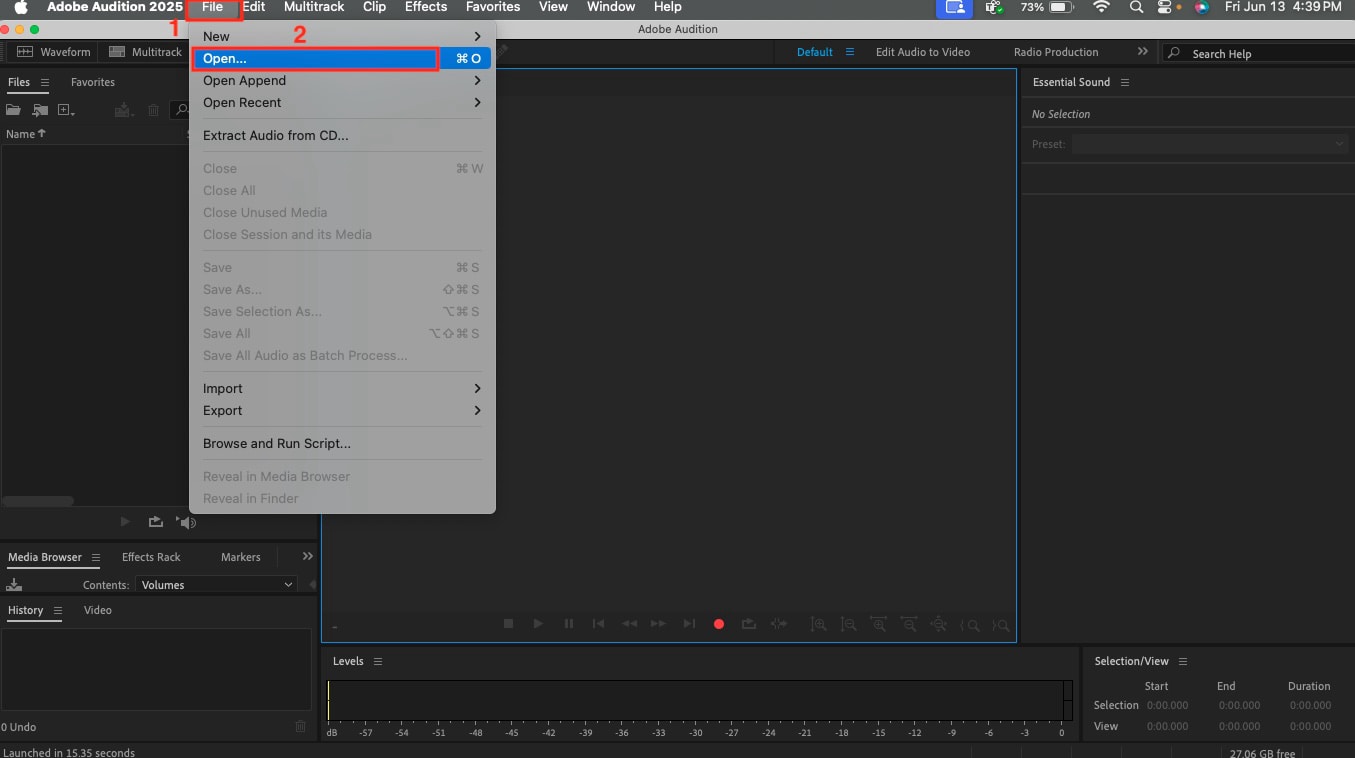
Step 2: Once the upload is complete, select all by pressing "Ctrl+A" in Windows or "Command+A" in Mac. Now, navigate to "Effects > Noise Reduction/Restoration > DeReverb."
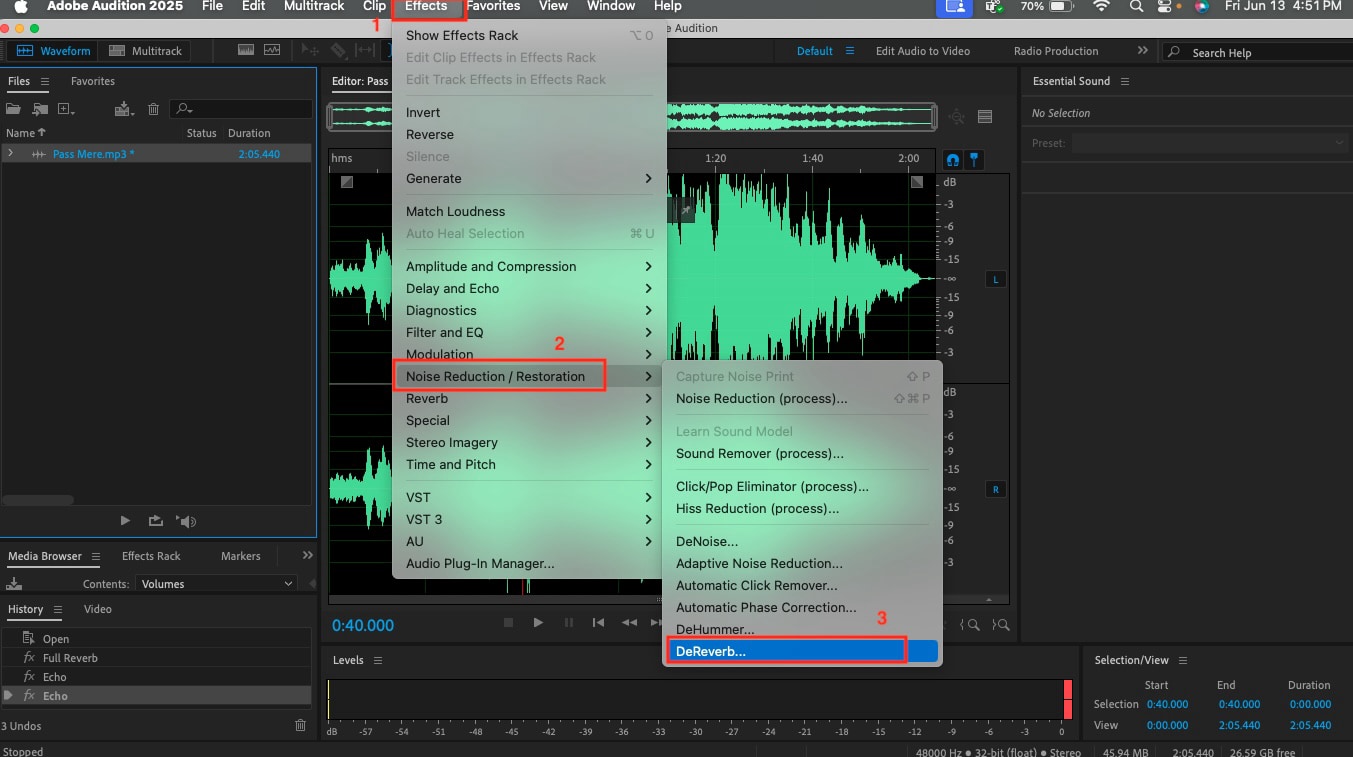
Step 3: A small tab will now open on your screen. Click the "Presets" option and select either "Heavy Reverb Reduction" or "Light Reverb Reduction." If your audio contains heavy echo, select "Heavy Reverb Reduction."
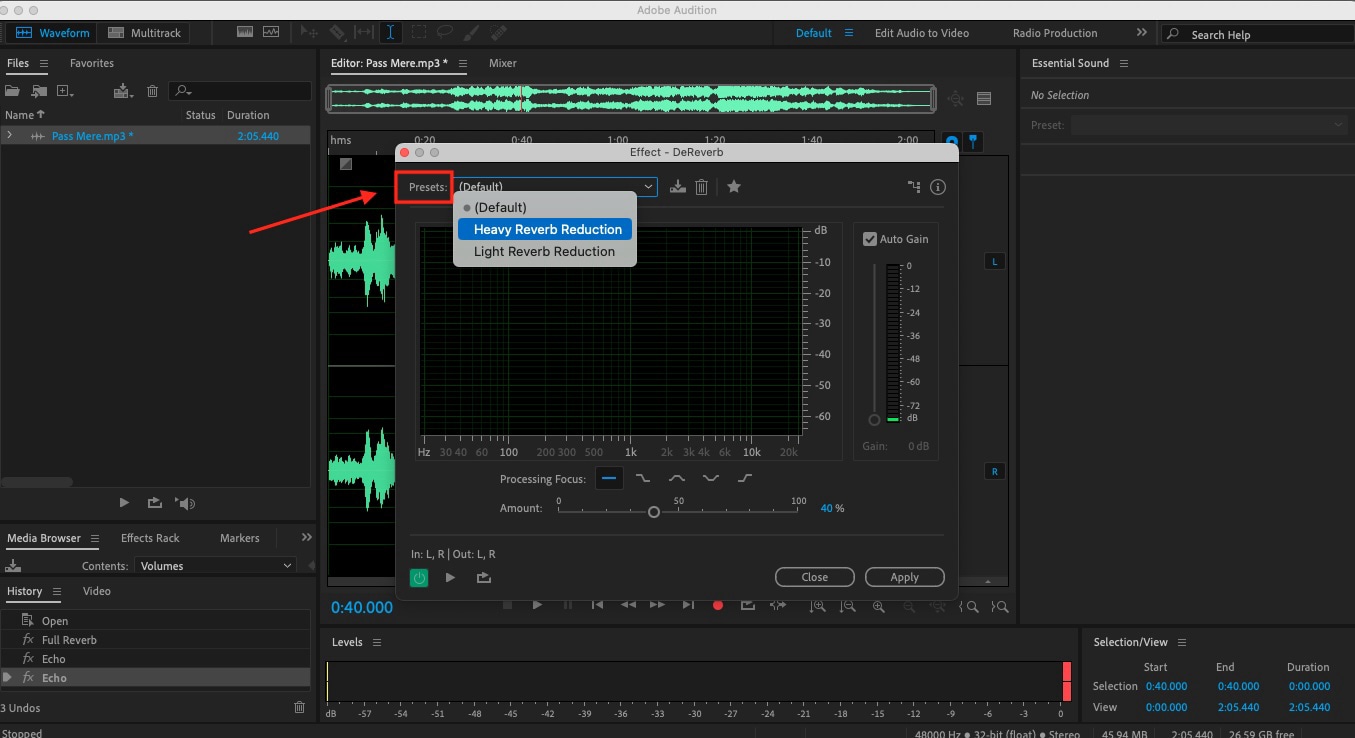
Step 4: After setting presets, adjust the echo settings. Adjust “Auto Gain > Processing Focus > Amount.” After changing the settings, click the "Apply" button.
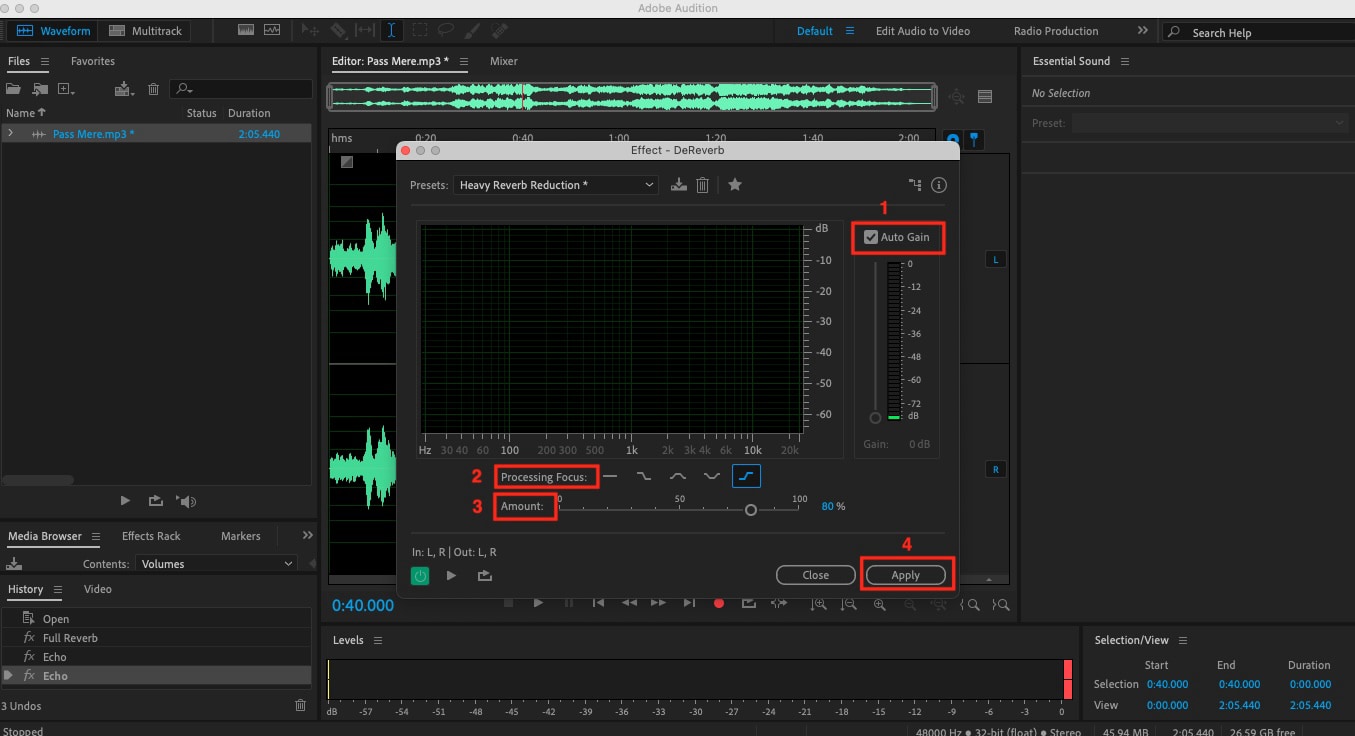
Step 5: Once the changes are complete, listen to the audio, navigate to "File" in the upper-right menu bar, and click "Export > File."
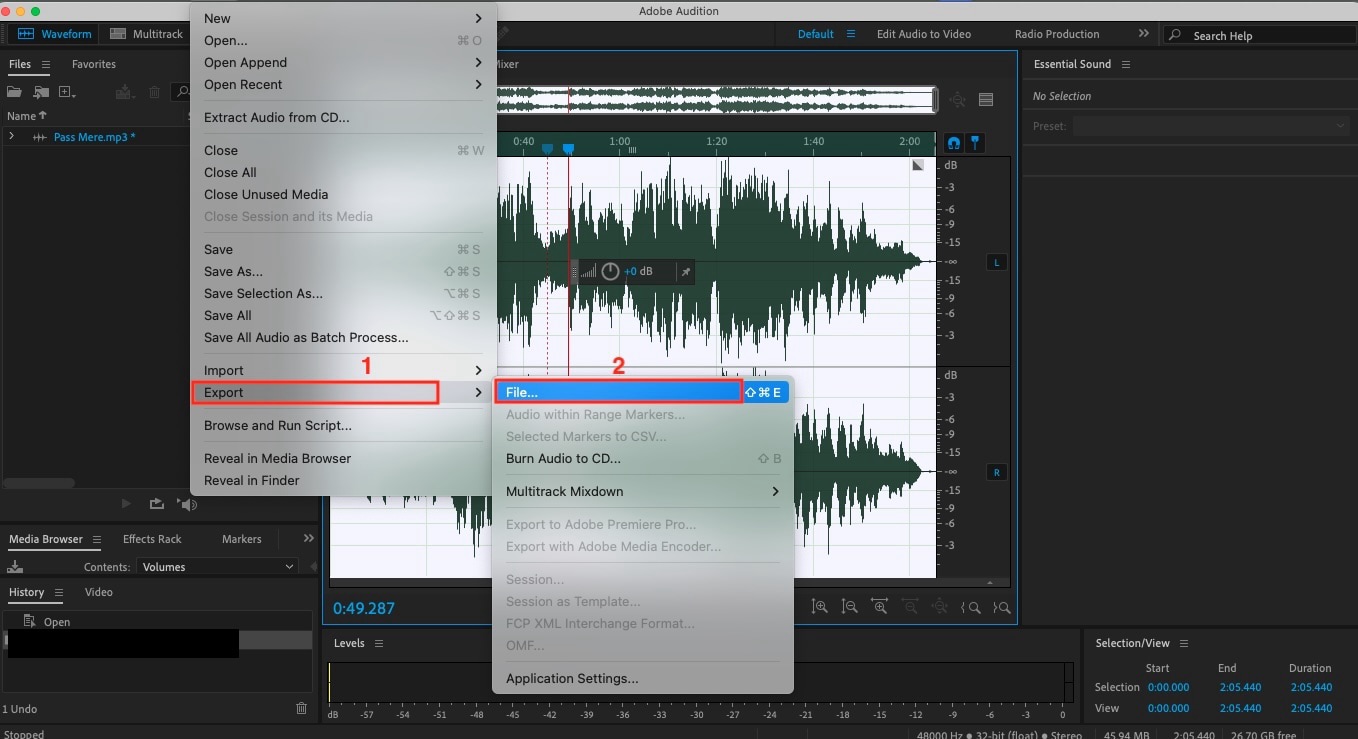
Method 2: How to Use Adobe Audition to Reduce Echo Using Filter and EQ Method
Step 1: Open the "File > Open" to upload the audio file.
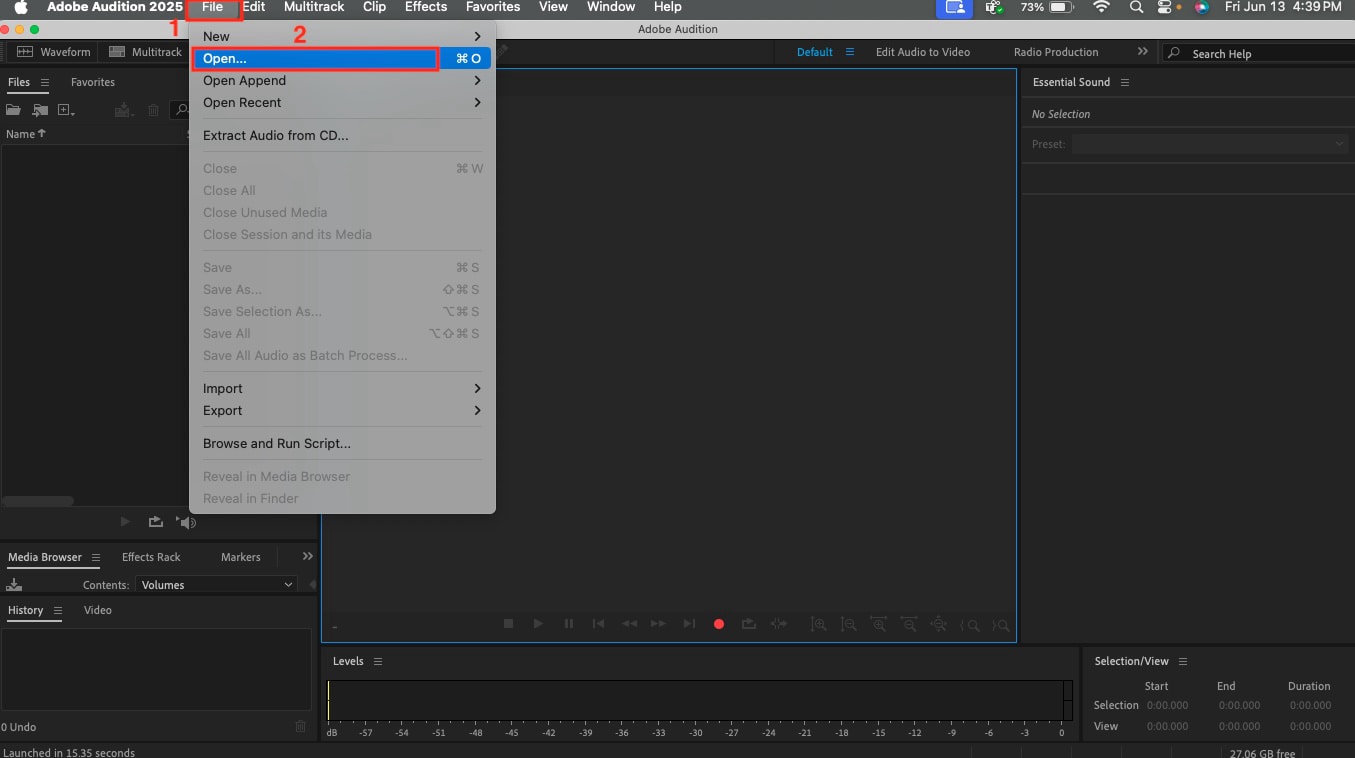
Step 2: After uploading the audio, click on "Effects" from the top bar menu and navigate to "Filter and EQ > Parametric Equalizer."
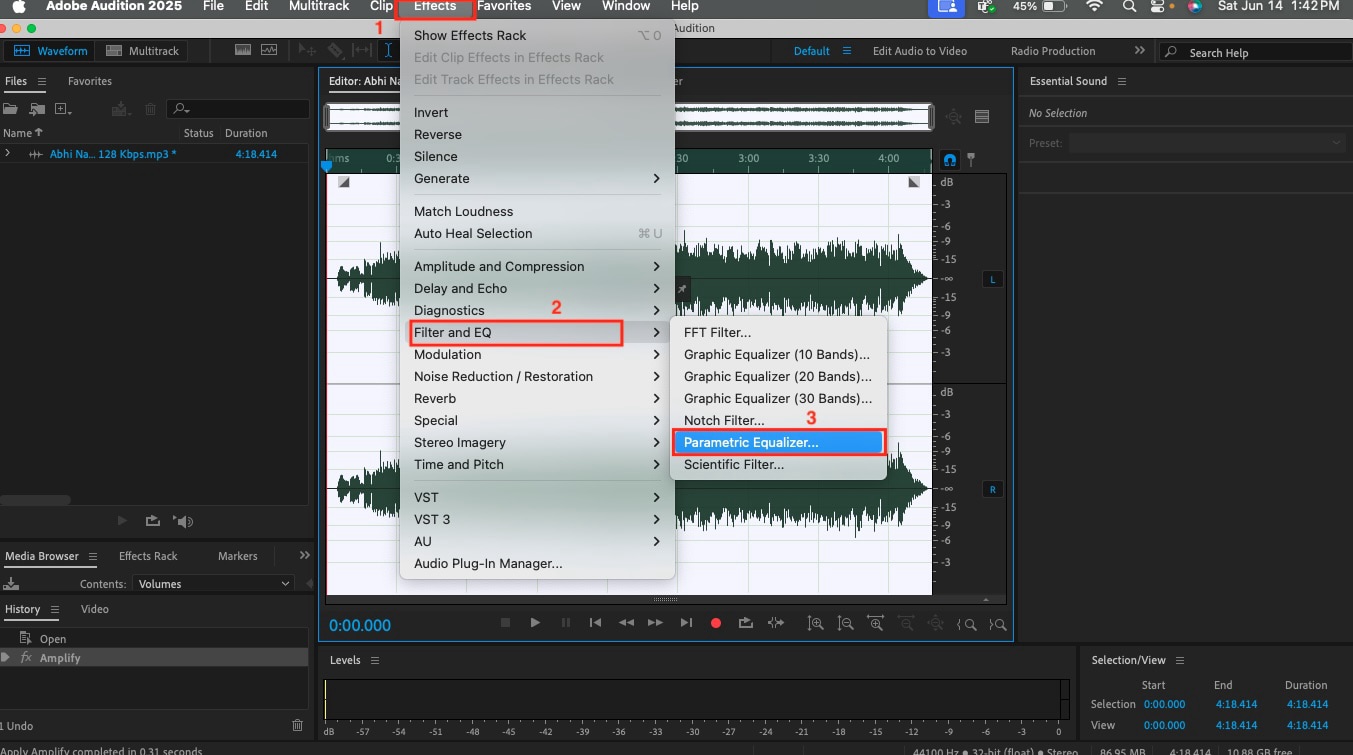
Step 3: Click "Presets" and select any option according to your preference.
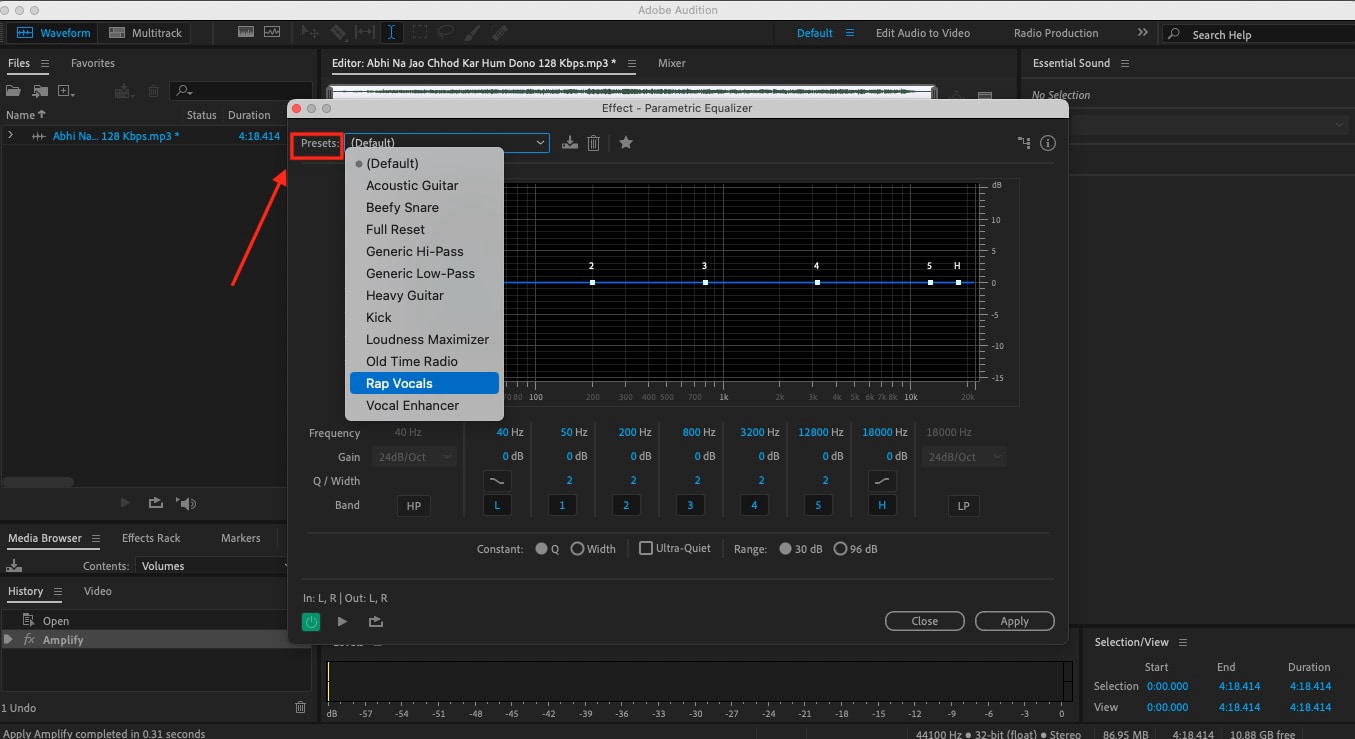
Step 4: Adjust the frequency, gain, width, and band, and click the "Apply" button to apply the changes.
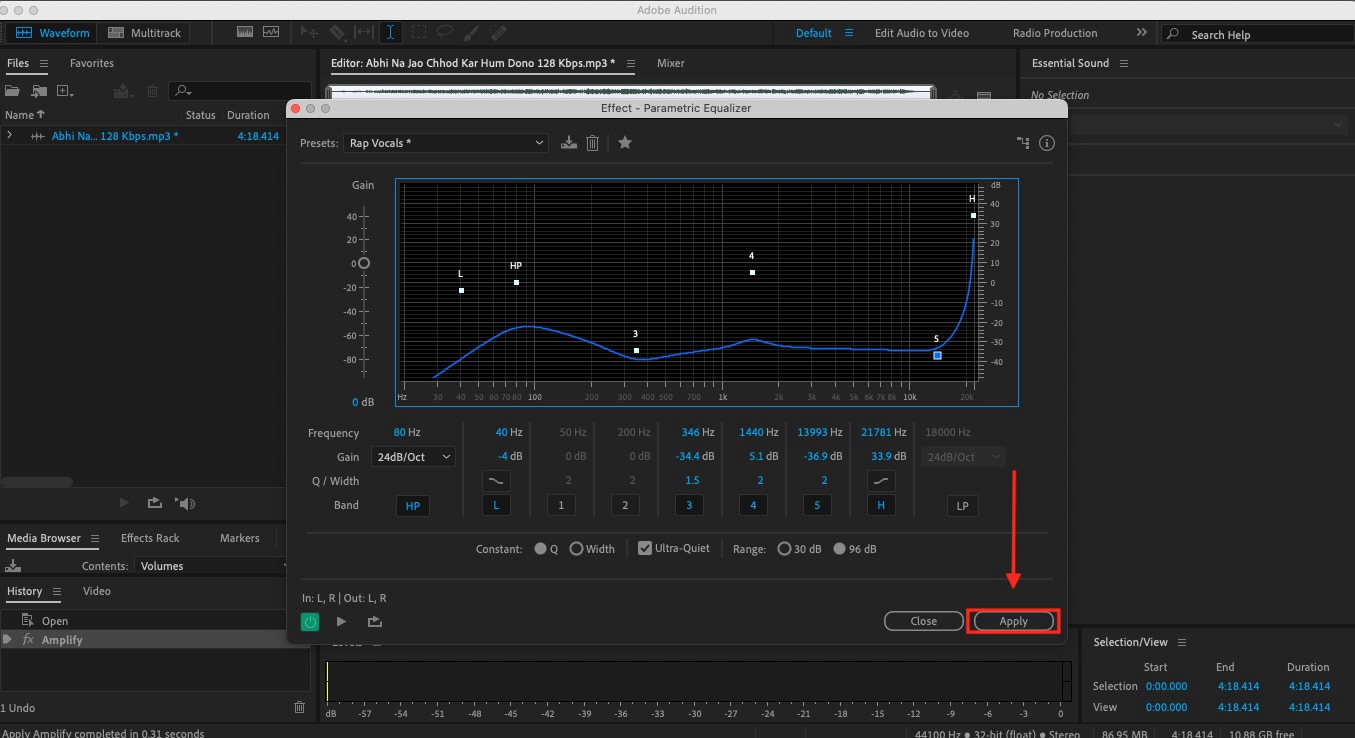
Step 5: After listening to the audio again, click "File" in the upper tab. Then, click "Export > File" to save the final audio to your system.
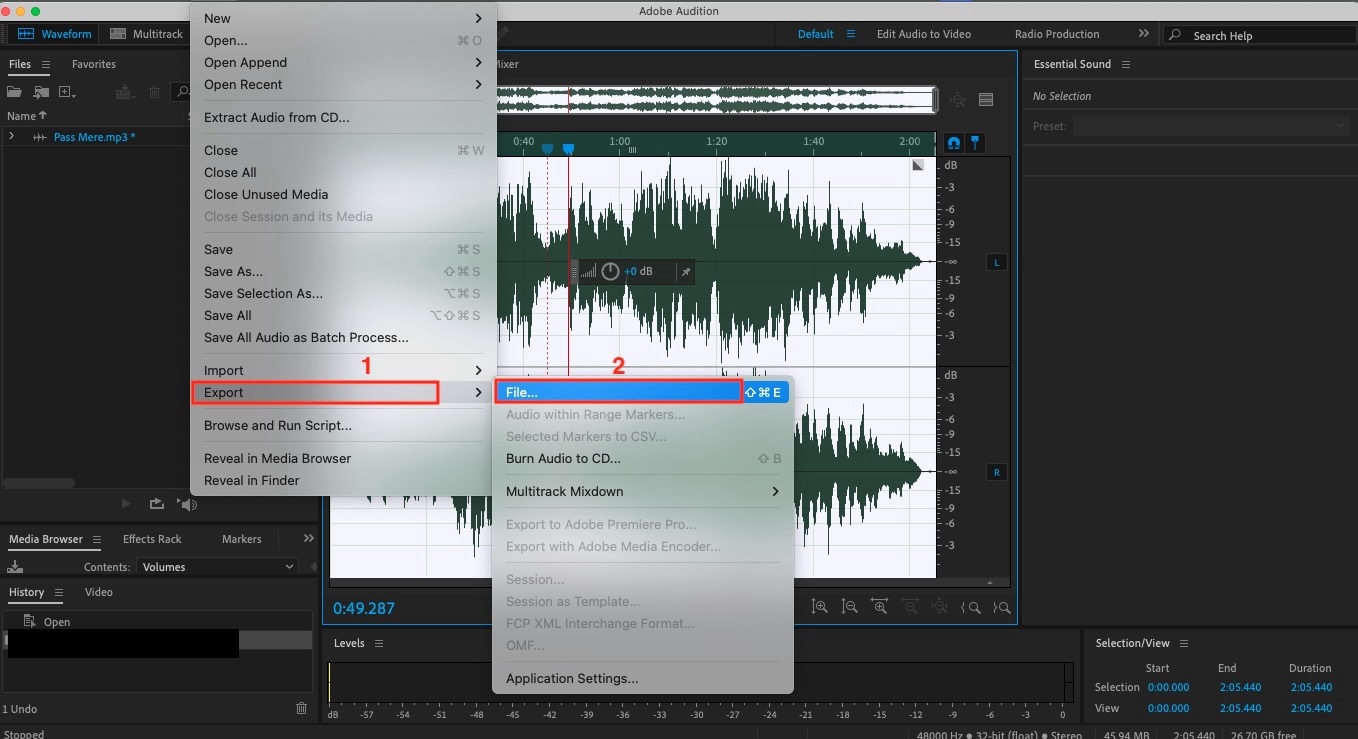
Method 3: How to Do Echo Removal in Audition Using Amplitude and Compression Method
Step 1: To upload the file, head to the "File > Open" option.

Step 2: After uploading the file, click "Effects" and navigate to "Amplitude and Compression > Dynamics."

Step 3: From the "Presets" section, select an option that meets your requirements.
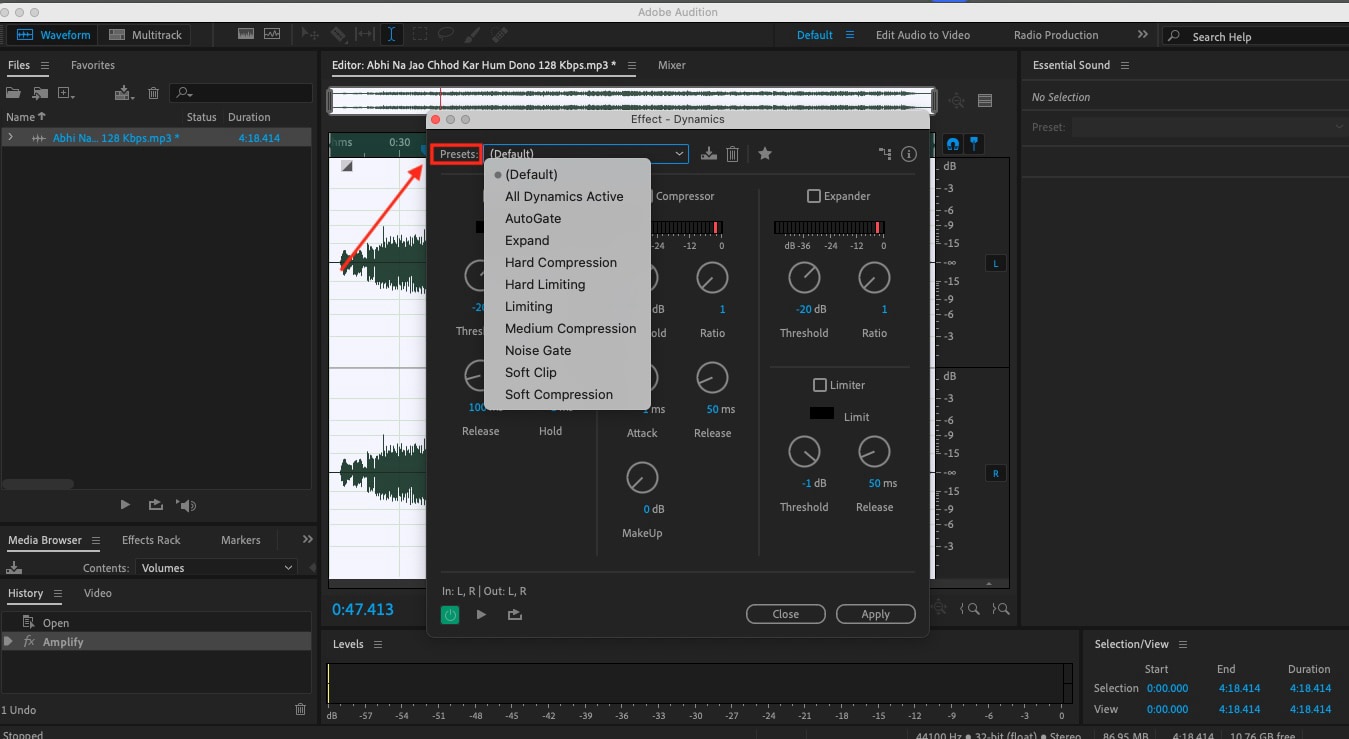
Step 4: After selecting presets, adjust the settings, such as AutoGate, Compressor, and Expander, and then click the "Apply" button.
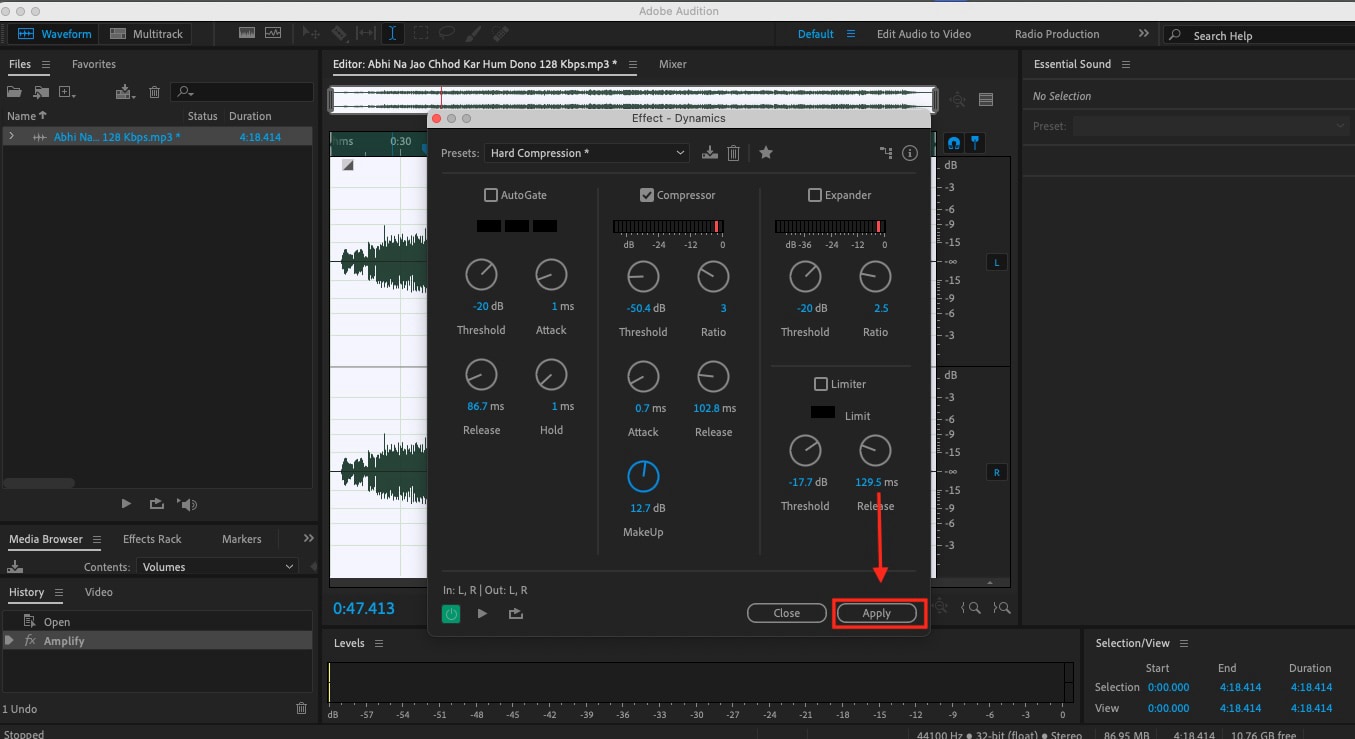
Step 5: Once all changes are made and you are satisfied with the results, click the “File” button from the menu bar and navigate to “Export > File.”
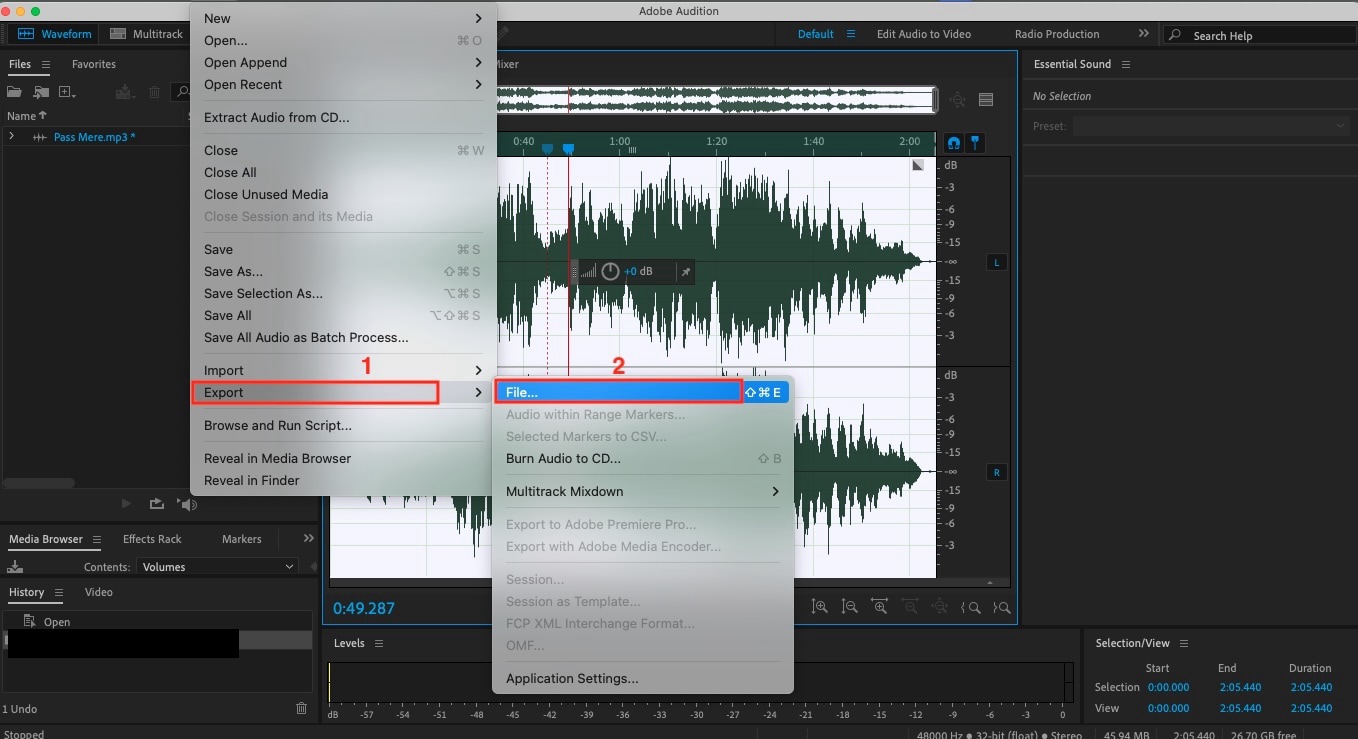
Limitations
- It is best suited for professionals, but for beginners, it may be too complex to understand and use effectively on the first attempt.
- If you're on a tight budget or want to test features for free, Adobe Audition might seem like a stretch.
- If you're working with a large number of audio tracks, say, more than a dozen, Audition can start slowing down or even crash. It's not the best for massive sessions.
- Audition is great for editing and cleaning up audio, but it's not built for music production. If you need MIDI sequencing or virtual instruments, you'll have to look elsewhere.
Part 3. Easier Way to Remove Echo from Audio/Video with One Click
Adobe Audition echo removal can be achieved in various ways, but its high pricing and steep learning curve often make room for other, easier, and budget-friendly options. Here are the top 5 AI-powered tools that remove echo quickly, and some of the tools also offer batch processing.
1. Wondershare UniConverter
Adobe Audition's reduce echo feature is beneficial, but it requires a certain level of technical expertise that may not be suitable for all users. For quick and easy solutions, Wondershare UniConverter's Noise Remover is the best choice. Its batch processing capabilities and AI-powered features deliver high-quality results with a single click.
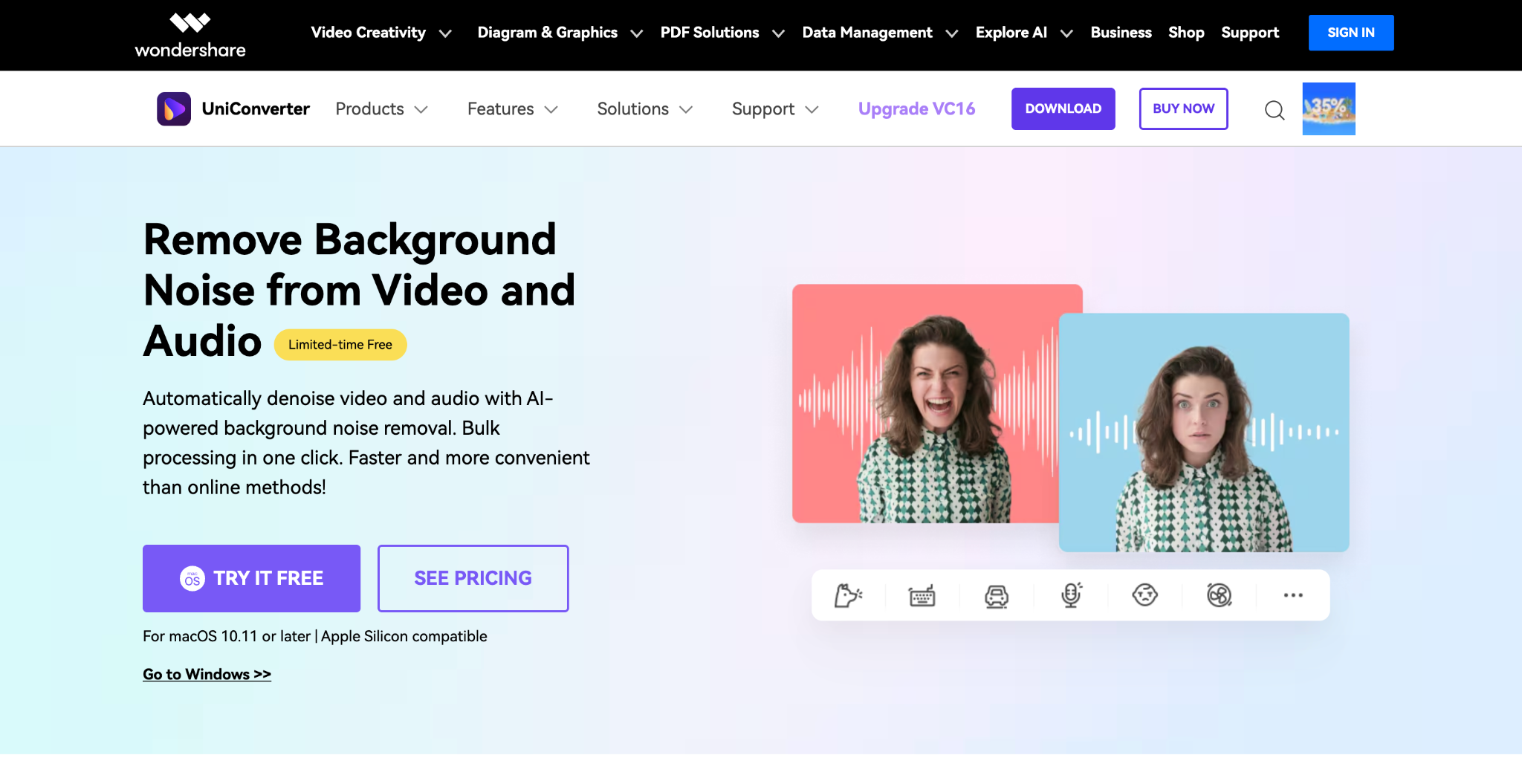
Key Features
- More than just a noise removal tool, it offers a range of other audio editing options, including text-to-speech and speech-to-text capabilities.
- Its vocal remover feature makes vocal and instrumental separation easy and quick.
- Voice changer lets you change the voice of your pre-existing audio and video to baby, radio, and transformer-like voices.
- It offers batch processing of both audio and video files.
Best AI Echo Remover
How to Remove Echo From Audio With Wondershare UniConverter
Step 1: On the homepage, you will see the four options: Hot, Video, Audio, and Image. Click "Audio > Noise Remover."
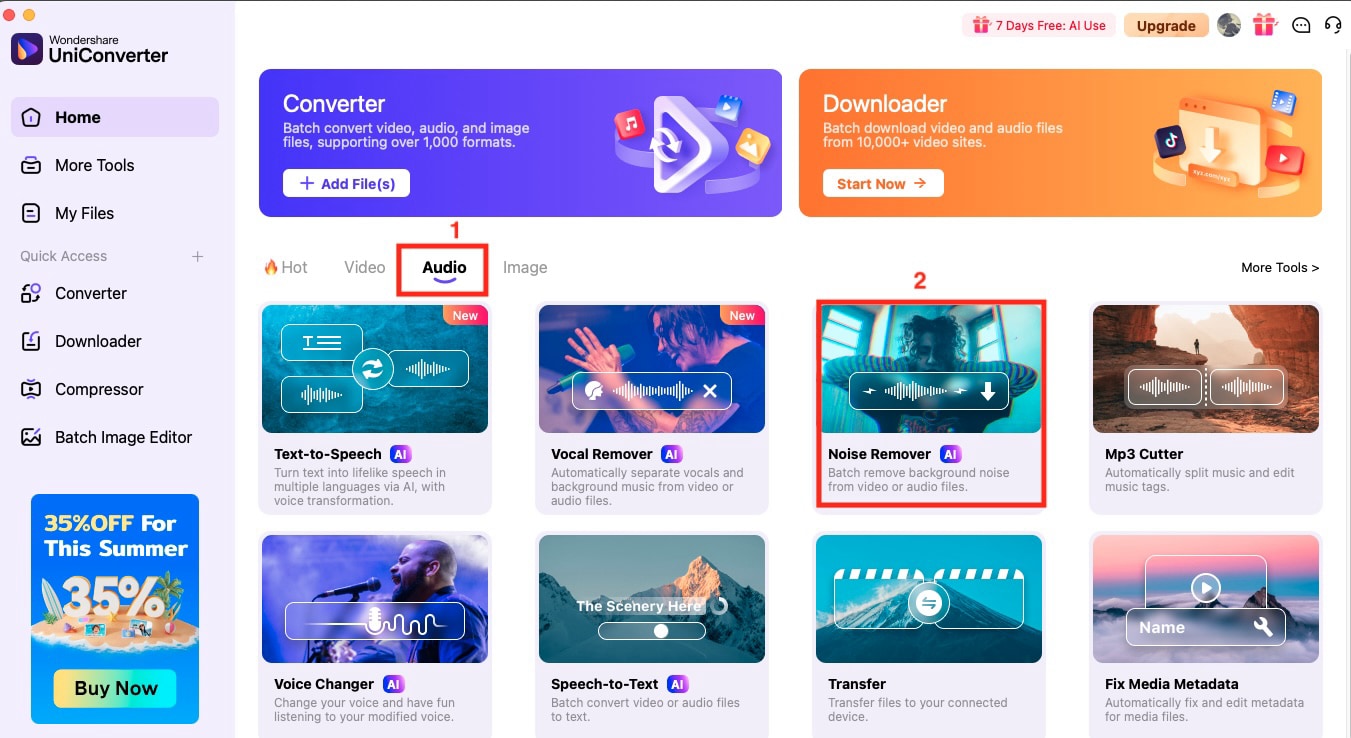
Step 2: You will see the "Add or Drag Audio/Video File" option; click it and upload one or more files at once.
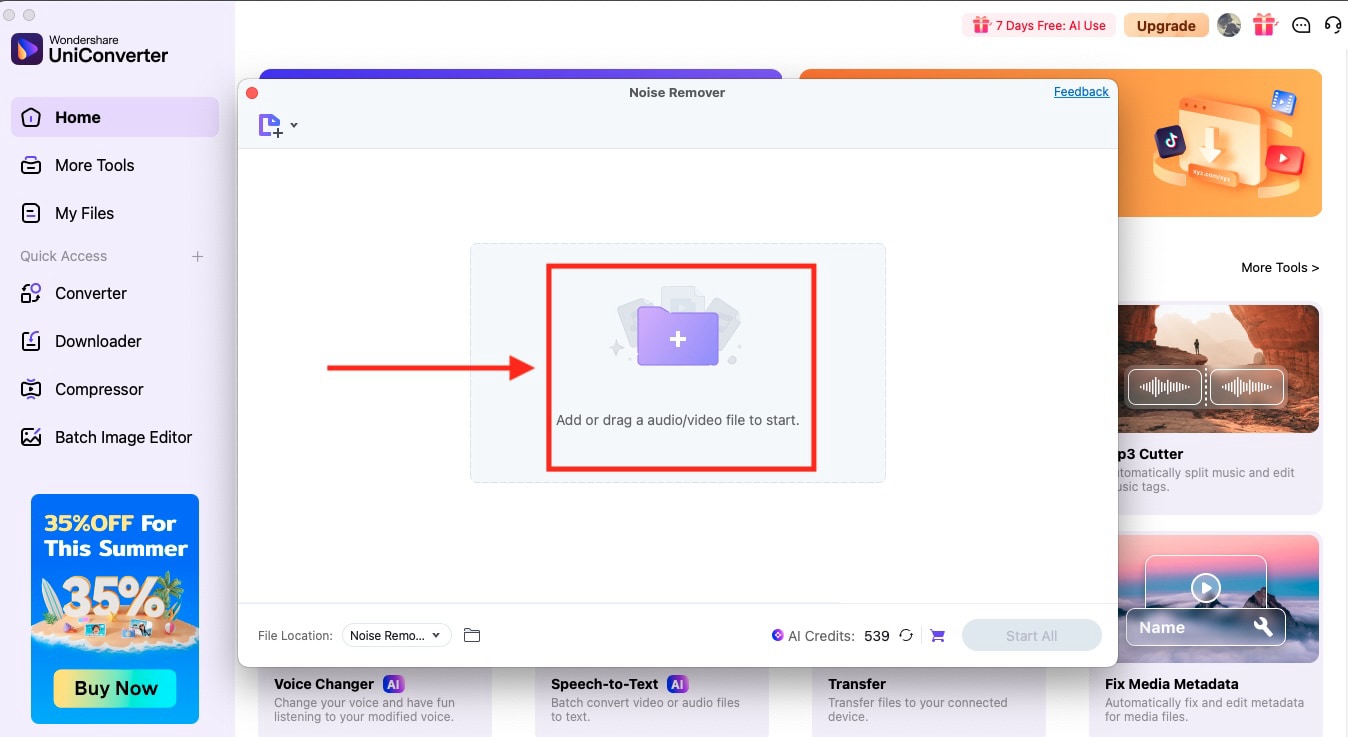
Step 3: Processing will take 20-25 seconds. Click the "Start All" button to remove the noise and export the file directly to your device.
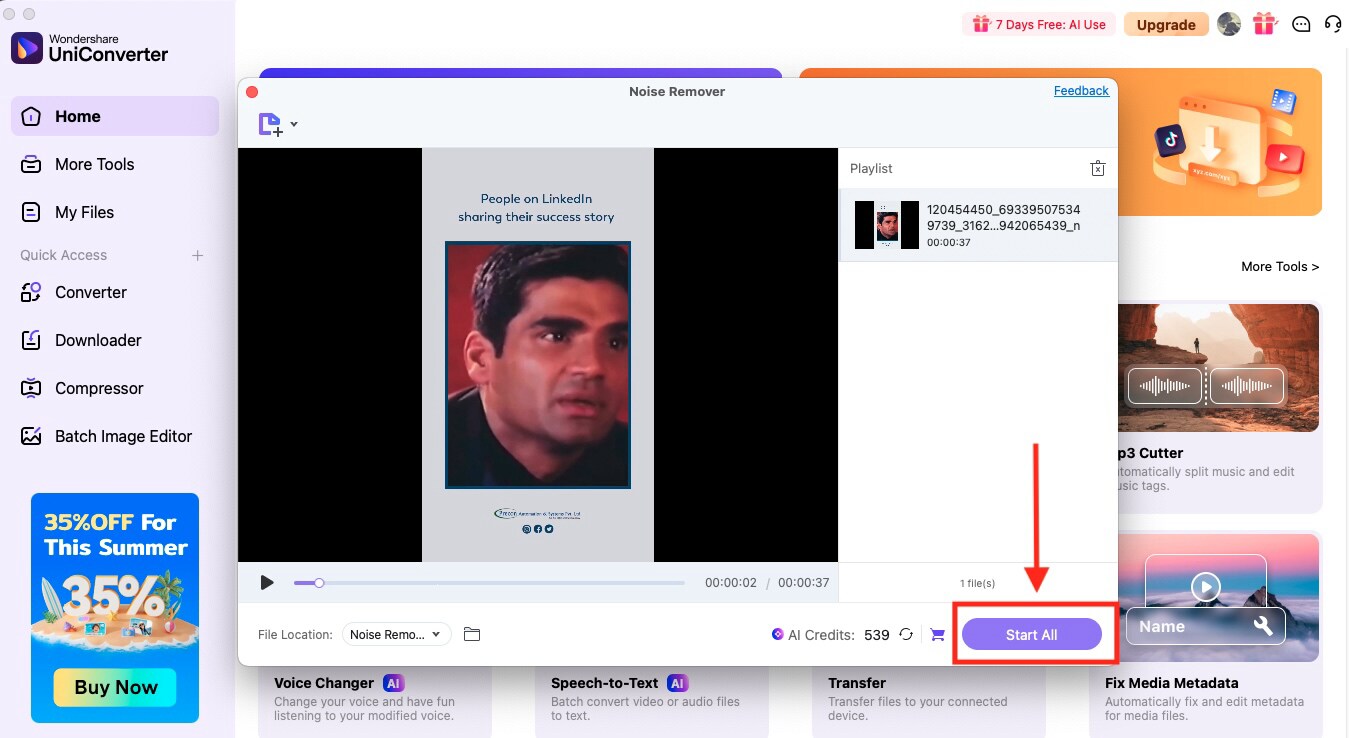
2. Audacity
Audacity is a free, open-source audio editor that allows you to remove echo using tools such as Noise Reduction and Noise Gate. You simply select a noise profile and apply the effect, tweaking settings for the best results. Besides echo removal, Audacity offers features such as multitrack editing, equalization, and audio effects, making it a versatile choice for podcasters, musicians, and anyone seeking cleaner, more professional audio.
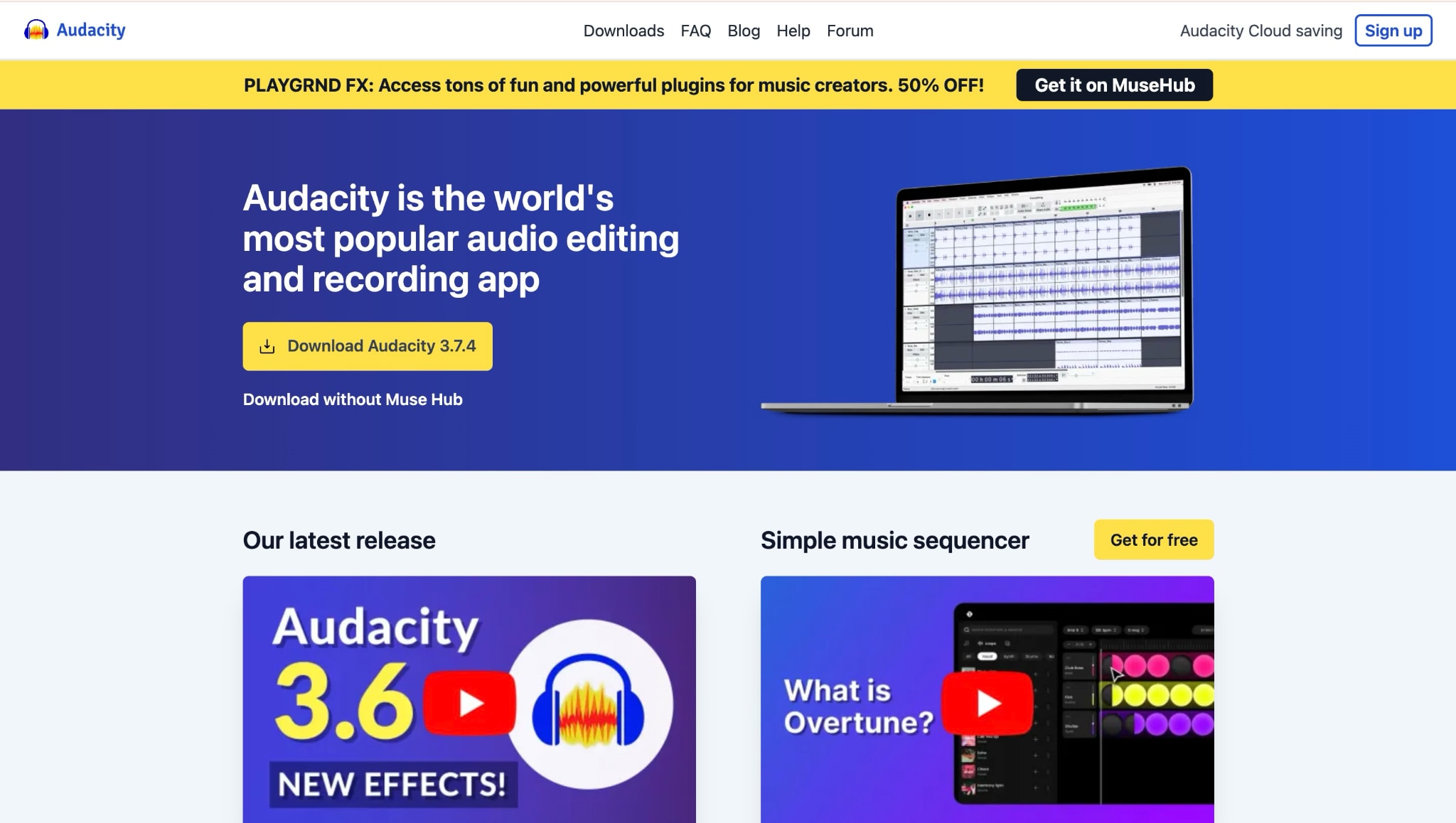
How to Remove Echo From Audio Using Audacity
Here is a step-by-step process to remove echo from your audio using Audacity:
Step 1: On the homepage, navigate to "File > Open" to upload the audio.
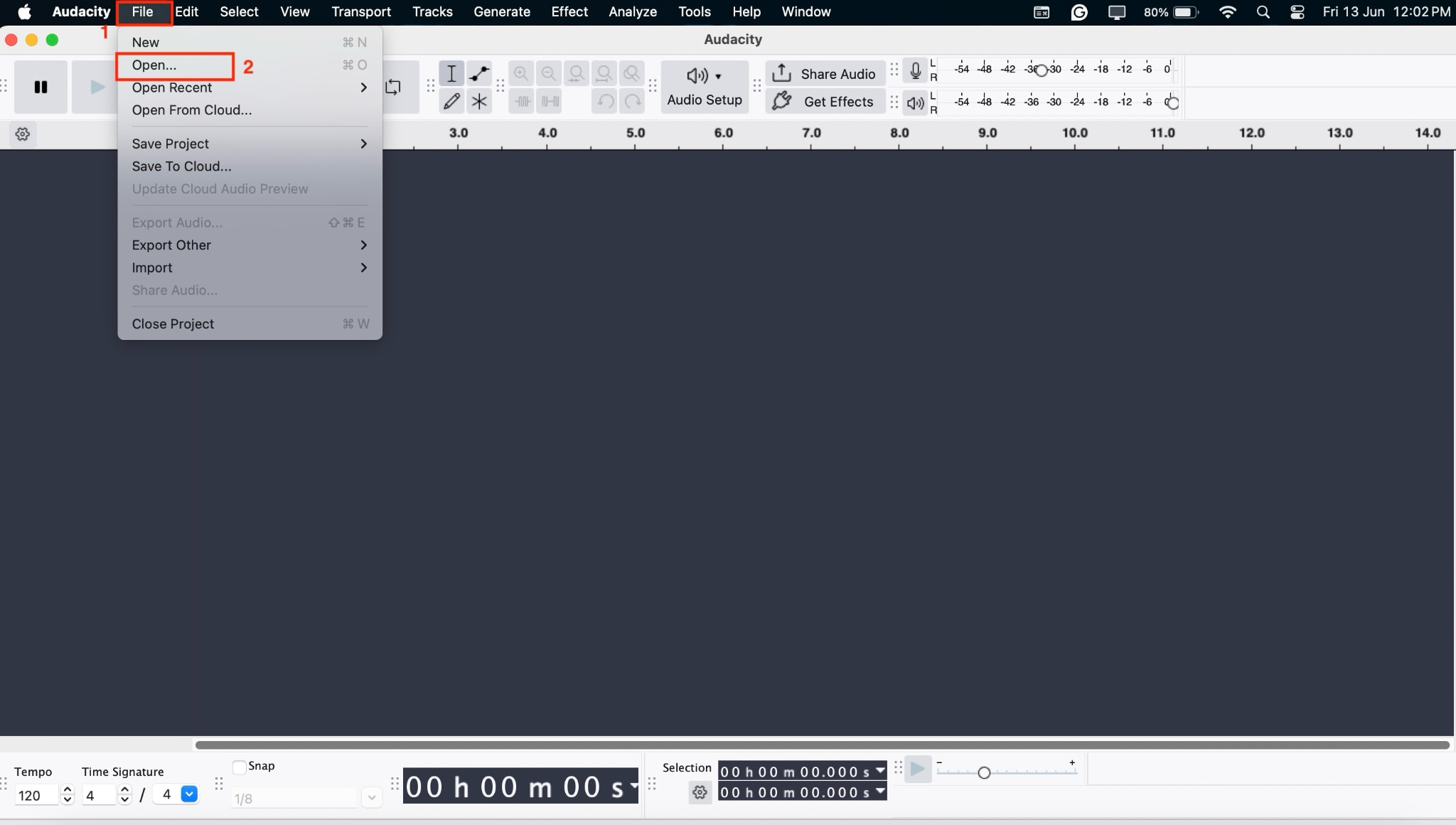
Step 2: After uploading your audio, select all, and head to "Effect > Delay and Reverb > Echo."
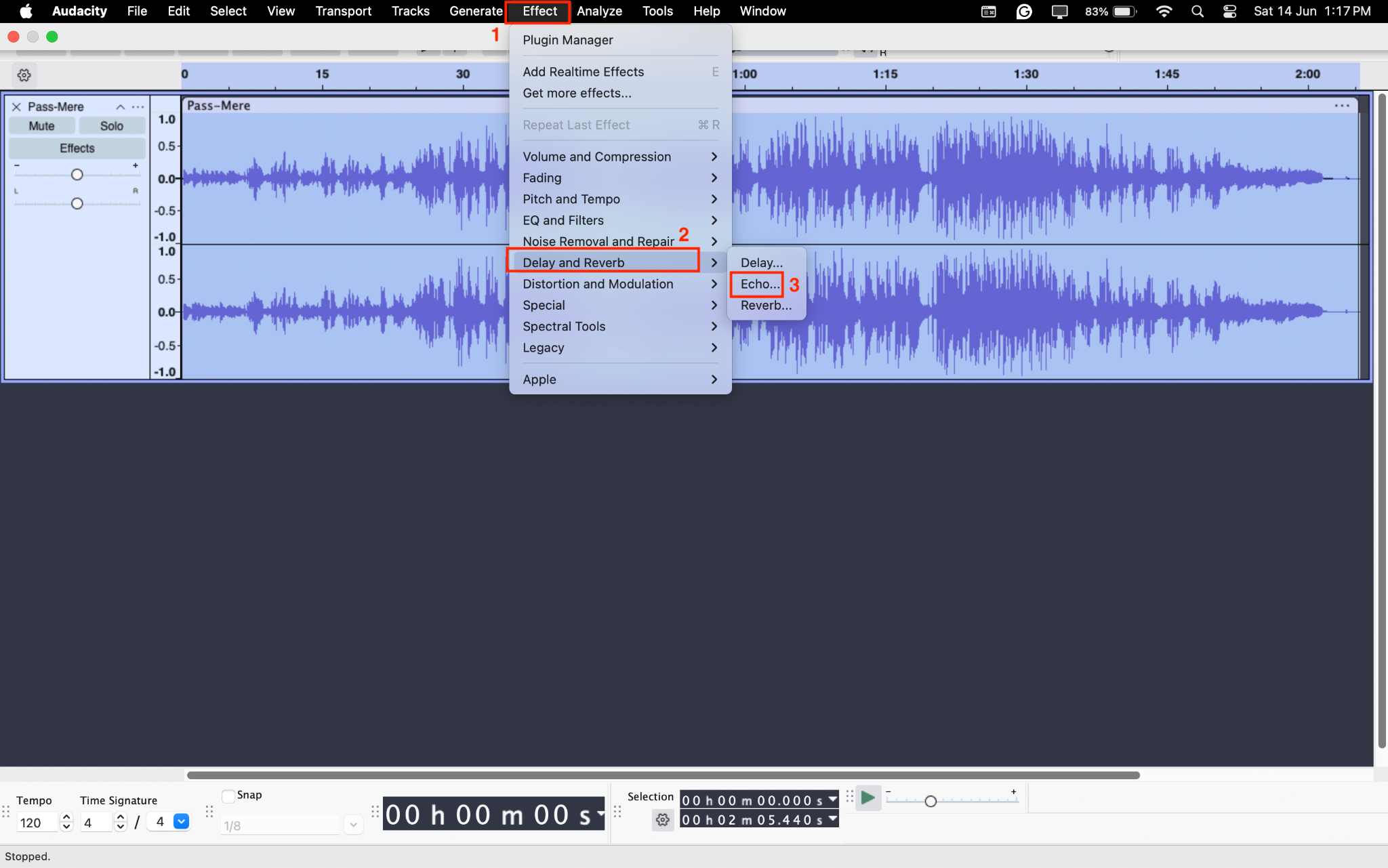
Step 3: A small tab will open with echo presets and settings. Adjust the settings, click on “Preview” to listen, and if satisfied, click the "Apply" button.

Step 4: Once you are satisfied with the saved results, click "File > Export Audio" to save the final audio.
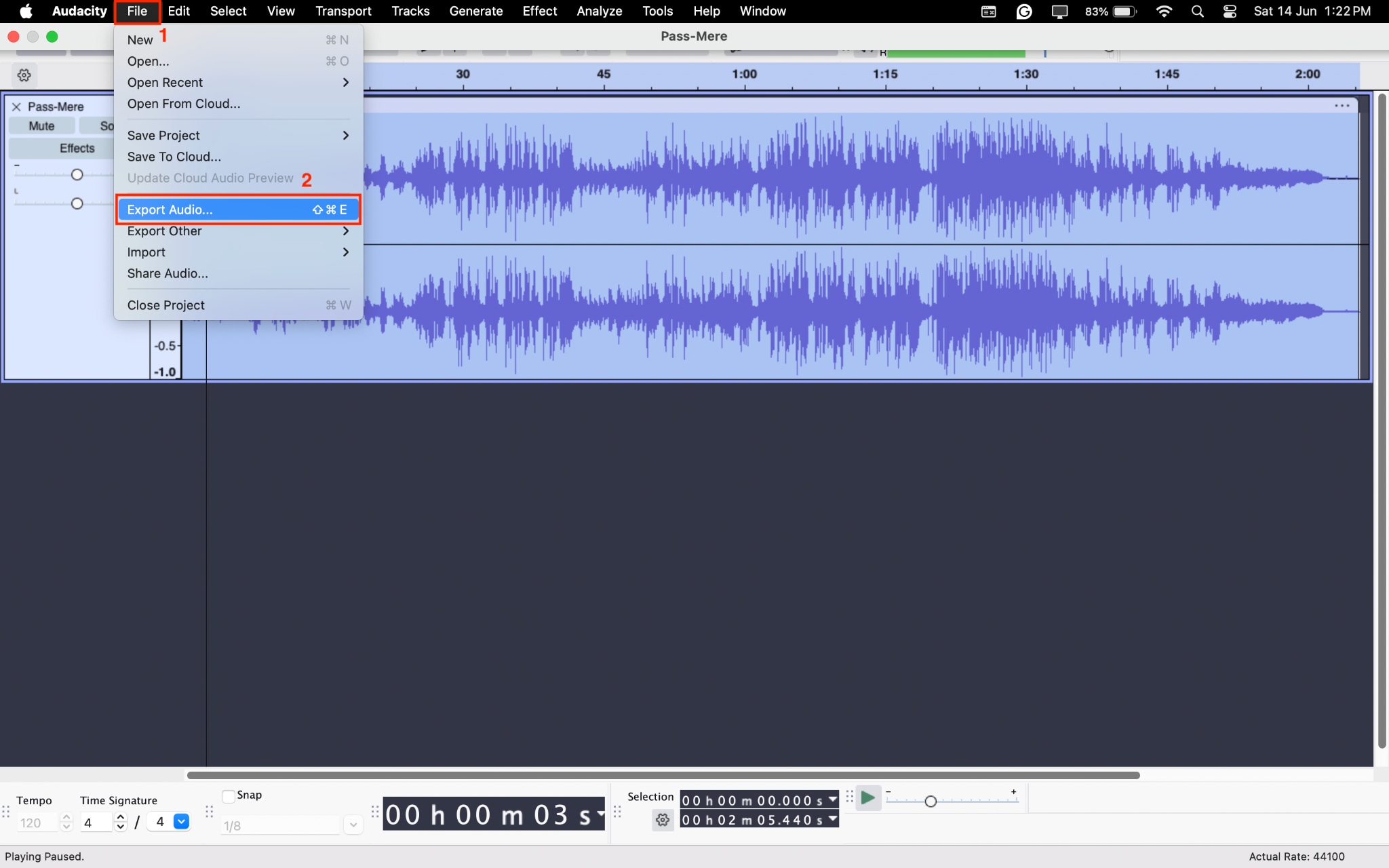
3. Adobe Podcast
Adobe Podcast AI's Enhance Speech feature utilizes advanced AI to automatically reduce echo and background noise from your recordings. Simply upload your audio, and the tool takes care of the rest. It also generates transcripts, lets you edit audio as easily as text, and polishes sound for a crisp, studio-quality finish. It's perfect for podcasters and creators who want a hassle-free, pro-level audio cleanup.

How to Remove Echo From Audio Using Adobe Podcast
Step 1: On the homepage, click the "Enhance Speech" option. Then, select the "Drop File to Enhance" option to upload your audio. You can also enable the speech-to-enhance option if your audio has unclear or low sound quality.
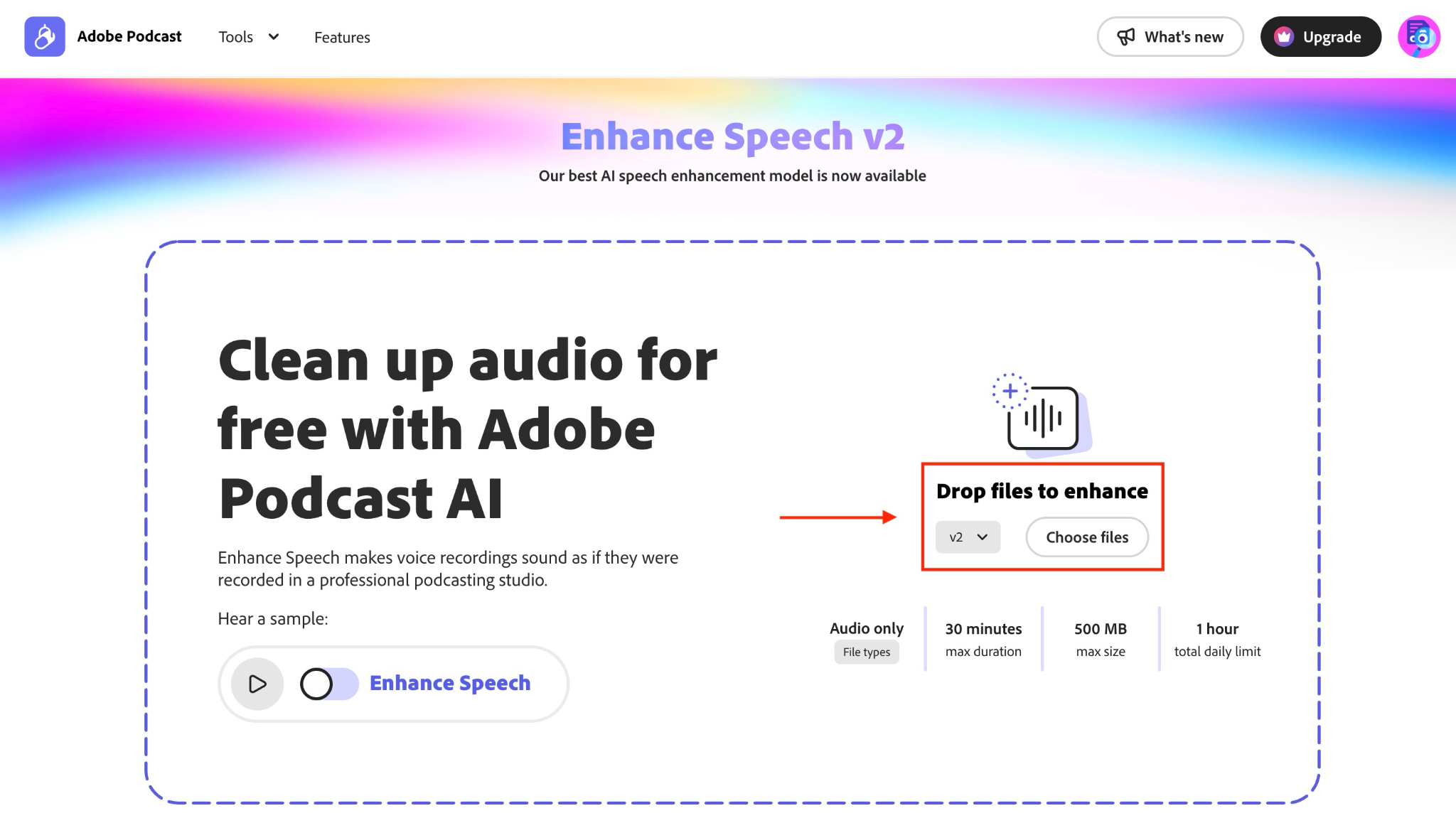
Step 2: After processing, you can listen to the audio and click the "Download" button to save your file in MP3.
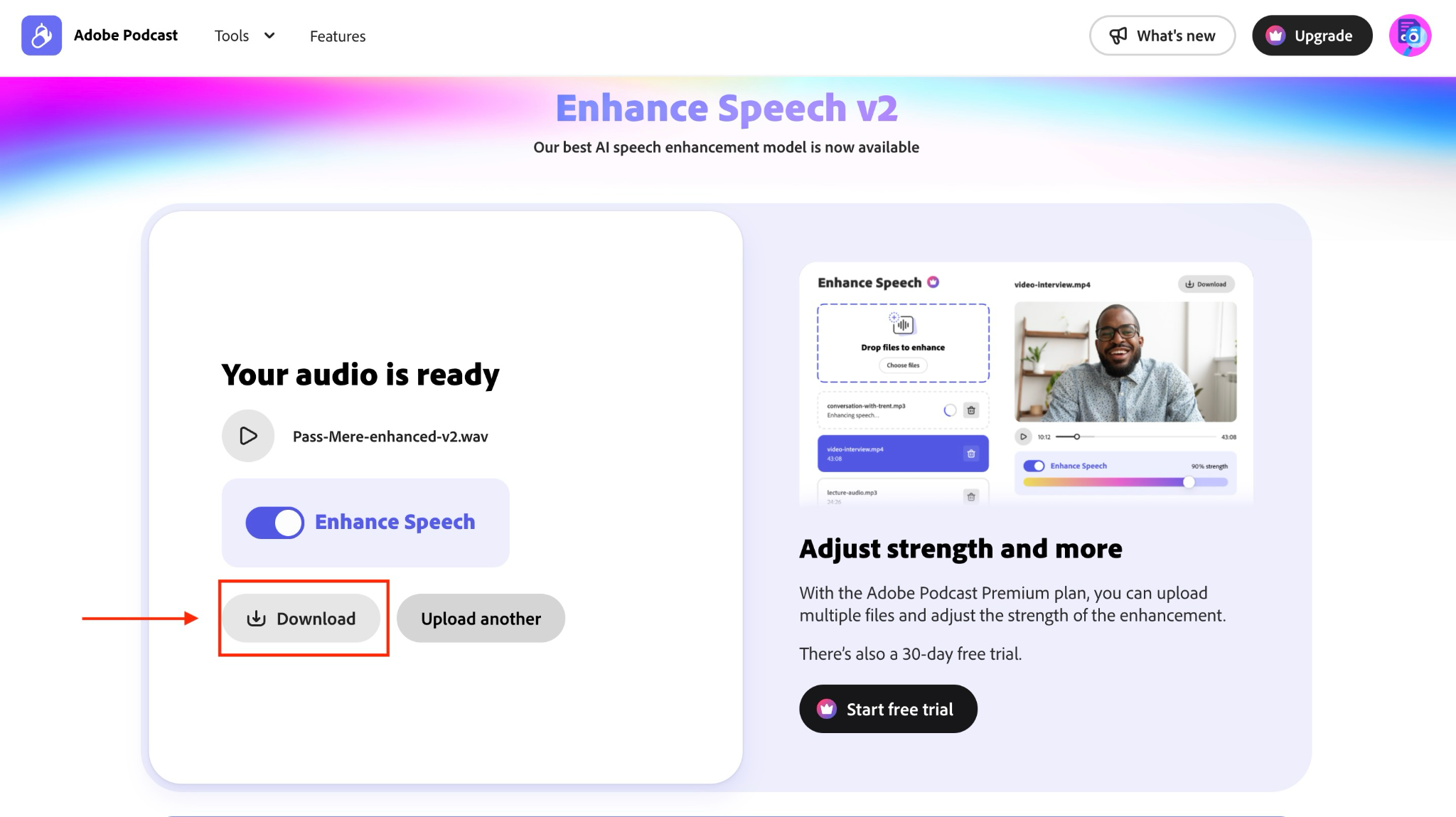
Part 4. Echo Prevention Tips for Future Recordings
Here are some tips to prevent echo, so you might not even need to use Audition or other tools to remove it later.
- Improve Mic and Room Setup: Position your mic 6 inches from your mouth and record in smaller rooms with plenty of furniture, carpets, and soft materials that naturally absorb sound reflections.
- Use Pop Filters and Absorption Panels: Invest in foam panels for your walls and a pop filter for your microphone to reduce plosive sounds and minimize unwanted reflections bouncing back.
- Record Dry Audio for Easier Post-Editing: If you record in acoustically treated spaces with minimal reverb and echo, you'll have clean "dry" audio that's much easier to process and enhance during post-production without fighting existing echo problems.
Conclusion
Learning Adobe Audition echo removal methods is relatively easy, but it does have its complexities. Adobe Audition offers professional-grade tools, such as DeReverb and parametric equalizers, which can be overwhelming for beginners and require technical expertise. The good news is that simpler alternatives are available.
For those wanting quick, hassle-free results, Wondershare UniConverter stands out with its one-click AI-powered noise removal and batch processing capabilities. Whether you're a podcaster, content creator, or just want cleaner audio, the right tool can make echo removal effortless. Try UniConverter today and see how it works perfectly for both beginners and professionals, delivering high-quality results.


